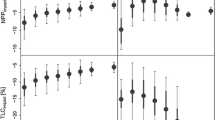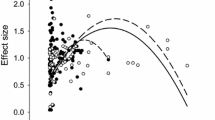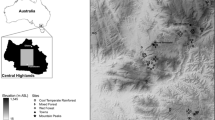Abstract
Context
Natural disturbances can have a considerable negative impact on the productivity of forest landscapes. Yet, disturbances are also important drivers of diversity, with diversity generally contributing positively to forest productivity. While the direct effects of disturbance have been investigated extensively it remains unclear how disturbance-mediated changes in diversity influence landscape productivity. Considering that disturbances are increasing in many ecosystems a better understanding of disturbance impacts is of growing importance for ecosystem management.
Objectives
Here, our objectives were to study the effect of disturbance on tree species diversity at different spatial scales (α and β diversity), and to analyze how a disturbance-mediated variation in tree species diversity affects forest productivity.
Methods
To account for long-term interactions between disturbance, diversity, and productivity and test a range of disturbance scenarios we used simulation modeling, focusing on a temperate forest landscape in Central Europe.
Results
We found an overall positive effect of disturbance on tree species diversity both with regard to α and β diversity, persisting under elevated disturbance frequencies. Productivity was enhanced by within- and between-stand diversity, with the effect of α diversity decreasing and that of β diversity increasing through the successional development. Positive diversity effects were found to be strongly contingent on the available species pool, with landscapes containing species with different life-history strategies responding most strongly to disturbance-mediated diversity.
Conclusions
We conclude that, rather than homogenizing disturbed areas, forest managers should incorporate the diversity created by disturbances into stand development to capitalize on a positive diversity effect on productivity.




Similar content being viewed by others
References
Baeten L, Verheyen K, Wirth C, Bruelheidec H, Bussottie F, Finérf L, Jaroszewiczg B, Selvie E, Augej H, Avăcăriei H, Barbarol L, Bărnoaiea I, Bastiash CC, Bauhusm J, Beinhoffd C, Benavidesh R, Benneterm A, Bergern S, Bertholdd F, Bobergo J, Bonalp D, Brüggemannq W, Carnolr M, Castagneyroll B, Charbonnierl Y, Chećko E, Coomess E (2013) A novel comparative research platform designed to determine the functional significance of tree species diversity in European forests. Perspect Plant Ecol Evol Syst 15:281–291. doi:10.1016/j.ppees.2013.07.002
Barwell LJ, Isaac NJB, Kunin WE (2015) Measuring β - diversity with species abundance data. J Anim Ecol. doi:10.1111/1365-2656.12362
Bohn U, Gollub G, Hettwer C, Neuhäuslová WH, Raus T, Schlüter H (2004) Karte der natürlichen Vegetation Europe/Map of the Natural Vegetation of Europe Maßtab/Scale 1:2500000. Conservation Bundesamt für Naturschutz (Federal Agency for Nature), Bonn
Boyd IL, Freer-Smith PH, Gilligan CA, Godfray HCJ (2013) The consequence of tree pests and diseases for ecosystem services. Science 342:1235773. doi:10.1126/science.1235773
Busby PE, Motzkin G, Boose ER (2008) Landscape-level variation in forest response to hurricane disturbance across a storm track. Can J For Res 38:2942–2950. doi:10.1139/X08-139
Chisholm RA, Muller-Landau HC, Abdul Rahman K, Bebber DP, Bin Y, Bohlman SA, Bohlman SA (2013) Scale-dependent relationships between tree species richness and ecosystem function in forests. J Ecol 101:1214–1224. doi:10.1111/1365-2745.12132
Connell J (1978) Diversity in tropical rain forests and coral reefs. Science 199:1302–1310. doi:10.1126/science.199.4335.1302
Dale VH, Joyce LA, Mcnulty S, Neilson RP, Ayres MP, Flannigan MD, Hanson PJ, Irland LC, Lugo AL, Peterson CJ, Simberloff D, Swanson FJ, Stocks BJ, Wotton BM (2001) Climate change and forest disturbances. Bioscience 51:723–734. doi:10.1641/0006-3568(2001)051[0723:CCAFD]2.0.CO;2
Déqué M, Somot S, Sanchez-Gomez E, Goodess CM, Jacob D, Lenderink G, Christensen OB (2011) The spread amongst ENSEMBLES regional scenarios: regional climate models, driving general circulation models and interannual variability. Clim Dyn 38:951–964. doi:10.1007/s00382-011-1053-x
Dornelas M (2010) Disturbance and change in biodiversity. Philos Trans R Soc Lond B Biol Sci 365:3719–3727. doi:10.1098/rstb.2010.0295
Duursma RA, Marshall JD, Robinson AP, Pangle RE (2007) Description and test of a simple process-based model of forest growth for mixed-species stands. Ecol Modell 203:297–311. doi:10.1016/j.ecolmodel.2006.11.032
Elkin CM, Possingham H (2008) The role of landscape-dependent disturbance and dispersal in metapopulation persistence. Am Nat 172:563–575. doi:10.1086/590962
Fox JW (2013) The intermediate disturbance hypothesis should be abandoned. Trends Ecol Evol 28:86–92. doi:10.1016/j.tree.2012.08.014
Franklin JF, Spies TA, Van Pelt R, Carey AB, Thornburgh DA, Berg DR, Lindenmayer DB, Harmon ME, Keeton WS, Shaw DC, Bible K, Chen J (2002) Disturbances and structural development of natural forest ecosystems with silvicultural implications, using Douglas-fir forests as an example. For Ecol Manag 155:399–423
Garrison A, Miller A, Roxburgh SH, Shea K (2012) More bang for the land manager’s buck: disturbance autocorrelation can be used to achieve management objectives at no additional cost. J Appl Ecol 49:1020–1027. doi:10.1111/j.1365-2664.2012.02187.x
Gaston KJ, Fuller RA (2008) Commonness, population depletion and conservation biology. Trends Ecol Evol 23:14–19. doi:10.1016/j.tree.2007.11.001
Gough CM, Hardiman BS, Nave LE, Bohrer G, Maurer KD, Vogel CS, Nadelhoffer KJ, Curtis PS (2013) Sustained carbon uptake and storage following moderate disturbance in a Great Lakes forest. Ecol Appl 23:1202–1215. doi:10.1890/12-1554.1
Hughes AR, Byrnes JE, Kimbro DL, Stachowicz JJ (2007) Reciprocal relationships and potential feedbacks between biodiversity and disturbance. Ecol Lett 10:849–864. doi:10.1111/j.1461-0248.2007.01075.x
Huston MA (1994) Biological diversity: the coexistence of species on changing landscapes. Cambridge University Press, Cambridge
Huston MA (2014) Disturbance, productivity, and species diversity: empiricism vs. logic in ecological theory. Ecology 95:2382–2396. doi:10.1890/13-1397.1
Jost L (2007) Partitioning diversity into independent alpha and beta components. Ecology 88:2427–2439. doi:10.1890/06-1736.1
Kirwan L, Connolly J, Finn JA, Brophy C, Lüscher A, Nyfeler D, Sebastia MT (2009) Diversity-interaction modeling: estimating contributions of species identities and interactions to ecosystem function. Ecology 90:2032–2038. doi:10.1890/08-1684.1
Kondoh M (2001) Unifying the relationships of species richness to productivity and disturbance. Proc Biol Sci 268:269–271. doi:10.1098/rspb.2000.1384
Landsberg JJ, Waring RH (1997) A generalised model of forest productivity using simplified concepts of radiation-use efficiency, carbon balance and partitioning. For Ecol Manag 95:209–228
Lasky JR, Uriarte M, Boukili VK, Erickson DL, John Kress W, Chazdon RL (2014) The relationship between tree biodiversity and biomass dynamics changes with tropical forest succession. Ecol Lett 17:1158–1167. doi:10.1111/ele.12322
Lebourgeois F, Gomez N, Pinto P, Mérian P (2013) Mixed stands reduce Abies alba tree-ring sensitivity to summer drought in the Vosges mountains, western Europe. For Ecol Manag 303:61–71. doi:10.1016/j.foreco.2013.04.003
Legendre P, De Cáceres M (2013) Beta diversity as the variance of community data: dissimilarity coefficients and partitioning. Ecol Lett 16:951–963. doi:10.1111/ele.12141
Lindroth A, Lagergren F, Grelle A, Klemedtsson L, Langvall OLA, Weslien PER, Tuulik J (2009) Storms can cause Europe-wide reduction in forest carbon sink. Glob Chang Biol 15:346–355. doi:10.1111/j.1365-2486.2008.01719.x
Loreau M, Hector A (2001) Partitioning selection and complementarity in biodiversity experiments. Nature 412:72–76. doi:10.1038/35083573
Mackey RL, Currie DJ (2001) The diversity-disturbance relationship: is it generally strong and peaked? Ecology 82:3479. doi:10.2307/2680166
Mayer M, Matthews B, Schindlbacher a A, Katzensteiner K (2014) Soil CO2 efflux from mountainous windthrow areas: dynamics over 12 years post-disturbance. Biogeosciences 11:6081–6093. doi:10.5194/bg-11-6081-2014
Miller AD, Roxburgh SH, Shea K (2011) How frequency and intensity shape diversity-disturbance relationships. Proc Natl Acad Sci USA 108:5643–5648. doi:10.1073/pnas.1018594108
Miller A, Reilly D, Bauman S, Shea K (2012a) Interactions between frequency and size of disturbance affect competitive outcomes. Ecol Res 27:783–791. doi:10.1007/s11284-012-0954-4
Miller AD, Roxburgh SH, Shea K (2012b) Timing of disturbance alters competitive outcomes and mechanisms of coexistence in an annual plant model. Theor Ecol 5:419–432. doi:10.1007/s12080-011-0133-1
Mori AS (2011) Ecosystem management based on natural disturbances: hierarchical context and non-equilibrium paradigm. J Appl Ecol 48:280–292. doi:10.1111/j.1365-2664.2010.01956.x
Mori AS, Furukawa T, Sasaki T (2013) Response diversity determines the resilience of ecosystems to environmental change. Biol Rev 88:349–364. doi:10.1111/brv.12004
Morin X, Fahse L, Scherer-Lorenzen M, Bugmann H (2011) Tree species richness promotes productivity in temperate forests through strong complementarity between species. Ecol Lett 14:1211–1219. doi:10.1111/j.1461-0248.2011.01691.x
Morin X, Fahse L, Mazancourt C, Scherer-Lorenzen M, Bugmann H (2014) Temporal stability in forest productivity increases with tree diversity due to asynchrony in species dynamics. Ecol Lett 17:1526–1535. doi:10.1111/ele.12357
Moser W, Hansen M (2006) The relationship between diversity and productivity in selected forests of the Lake States Region (USA): relative impact of species versus structural diversity. In: McRoberts RE, Reams GA, Van Deusen PC, McWilliams WH (eds) Proc. Proceedings of eighth annual forest inventory and analysis Symposium US, Department of Agriculture, Forest Service, pp 149–157
Nave LE, Vance ED, Swanston CW, Curtis PS (2011) Fire effects on temperate forest soil C and N storage. Ecol Appl 21:1189–1201. doi:10.1890/10-0660.1
Nguyen H, Herbohn J, Firn J, Lamb D (2012) Biodiversity–productivity relationships in small-scale mixed-species plantations using native species in Leyte province, Philippines. For Ecol Manag 274:81–90. doi:10.1016/j.foreco.2012.02.022
Paquette A, Messier C (2011) The effect of biodiversity on tree productivity: from temperate to boreal forests. Glob Ecol Biogeogr 20:170–180. doi:10.1111/j.1466-8238.2010.00592.x
Pasari JR, Levi T, Zavaleta ES, Tilman D (2013) Several scales of biodiversity affect ecosystem multifunctionality. Proc Natl Acad Sci USA 110:10219–10222. doi:10.1073/pnas.1220333110
Perot T, Vallet P, Archaux F (2013) Growth compensation in an oak–pine mixed forest following an outbreak of pine sawfly (Diprion pini). For Ecol Manag 295:155–161. doi:10.1016/j.foreco.2013.01.016
Peters EB, Wythers KR, Bradford JB, Reich PB (2013) Influence of disturbance on temperate forest productivity. Ecosystems 16:95–110. doi:10.1007/s10021-012-9599-y
Potter KM, Woodall CW (2014) Does biodiversity make a difference? Relationships between species richness, evolutionary diversity, and aboveground live tree biomass across US forests. For Ecol Manag. doi:10.1016/j.foreco.2013.06.026
Pretzsch H, Schütze G (2009) Transgressive overyielding in mixed compared with pure stands of Norway spruce and European beech in Central Europe: evidence on stand level and explanation on individual tree level. Eur J For Res 128:183–204. doi:10.1007/s10342-008-0215-9
R Core Team (2013) R: a language and environment for statistical computing. R Foundation for Statistical Computing, Vienna
Roxburgh SH, Shea K, Wilson JB (2004) The intermediate disturbance hypothesis: patch dynamics and mechanisms of species coexistence. Ecology 85:359–371. doi:10.1890/03-0266
Scherer-Lorenzen M (2014) The functional role of biodiversity in the context of global change. In: Coomes D, Burslem D, Simonson W (eds) Forests and global change. Cambridge University Press, Cambridge, pp 195–238
Seidl R, Blennow K (2012) Pervasive growth reduction in norway spruce forests following wind disturbance. PLoS ONE. doi:10.1371/journal.pone.0033301
Seidl R, Schelhaas M-J, Lindner M, Lexer MJ (2009) Modelling bark beetle disturbances in a large scale forest scenario model to assess climate change impacts and evaluate adaptive management strategies. Reg Environ Change 9:101–119. doi:10.1007/s10113-008-0068-2
Seidl R, Schelhaas M-J, Lexer MJ (2011) Unraveling the drivers of intensifying forest disturbance regimes in Europe. Glob Chang Biol 17:2842–2852. doi:10.1111/j.1365-2486.2011.02452.x
Seidl R, Rammer W, Scheller RM, Spies TA (2012a) An individual-based process model to simulate landscape-scale forest ecosystem dynamics. Ecol Modell 231:87–100. doi:10.1016/j.ecolmodel.2012.02.015
Seidl R, Spies T, Rammer W, Steel EA, Pabst RJ, Olsen K (2012b) Multi-scale drivers of spatial variation in old-growth forest carbon density disentangled with Lidar and an individual-based landscape model. Ecosystems 15:1321–1335. doi:10.1007/s10021-012-9587-2
Seidl R, Schelhaas M, Rammer W, Verkerk PJ (2014) Increasing forest disturbances in Europe and their impact on carbon storage. Nat Clim Chang 4:806–810. doi:10.1038/NCLIMATE2318
Shannon C, Weaver W (1949) The mathematical theory of communication. University of Illinois Presss, Champaign
Shea K, Roxburgh SH, Rauschert ESJ (2004) Moving from pattern to process: coexistence mechanisms under intermediate disturbance regimes. Ecol Lett 7:491–508. doi:10.1111/j.1461-0248.2004.00600.x
Silva Pedro M, Rammer W, Seidl R (2015) Tree species diversity mitigates disturbance impacts on the forest carbon cycle. Oecologia 177:619–630. doi:10.1007/s00442-014-3150-0
Spiecker H, Hansen J, Klimo E, Skovsgaard J, Sterba H, von Teuffel K (2004) Norway spruce conversion—options and consequences. Brill, Leiden
Svensson JR, Lindegarth M, Jonsson PR, Pavia H (2012) Disturbance-diversity models: what do they really predict and how are they tested? Proc R Soc B Biol Sci 279:2163–2170. doi:10.1098/rspb.2011.2620
Taylor AR, Seedre M, Brassard BW, Chen HYH (2014) Decline in net ecosystem productivity following canopy transition to late-succession forests. Ecosystems 17:778–791. doi:10.1007/s10021-014-9759-3
Thom D, Seidl R (2015) Natural disturbance impacts on ecosystem services and biodiversity in temperate and boreal forests. Biol Rev Biol Rev. doi:10.1111/brv.12193
Thom D, Seidl R, Steyrer G, Krehan H, Formayer H (2013) Slow and fast drivers of the natural disturbance regime in Central European forest ecosystems. For Ecol Manag 307:293–302. doi:10.1016/j.foreco.2013.07.017
Thompson I, Mackey B, McNulty S, Mosseler A (2009) Forest resilience, biodiversity, and climate change. A synthesis of the biodiversity/resilience/stability relationship in forest ecosystems. Secretariat of the Convention on Biological Diversity, Montreal, p 67
Tian X, Zhao F, Shu L, Wang M (2014) Changes in forest fire danger for south-western China in the 21st century. Int J Wildland Fire 23:185–195. doi:10.1071/WF13014
Tilman D, Wedin D, Knops J (1996) Productivity and sustainability influenced by biodiversity in grassland ecosystems. Nature 379:718–720. doi:10.1038/379718a0
Tomiczek C, Perny B, Cech T (2006) Zur Waldschutzsituation der Buche. BFW-Praxisinformation 12:19–21
Turner MG (2010) Disturbance and landscape dynamics in a changing world. Ecology 91:2833–2849. doi:10.1890/10-0097.1
Turner MG, Donato DC, Romme WH (2012) Consequences of spatial heterogeneity for ecosystem services in changing forest landscapes: priorities for future research. Landsc Ecol. doi:10.1007/s10980-012-9741-4
Vilà M, Inchausti P, Vayreda J, Barrantes O, Gracia C, Ibáñez JJ, Mata T (2005) Confounding factors in the observational productivity-diversity relationship in forests. In: Scherer-Lorenzen M, Körner K, Schulze E-D (eds) Forest diversity and function. Springer, Berlin, pp 65–86
Westerling AL, Hidalgo HG, Cayan DR, Swetnam TW (2006) Warming and earlier spring increase western U.S. forest wildfire activity. Science 313:940–943
White ST, Pickett PS (1985) The ecology of natural disturbance and patch dynamics. In: White ST, Pickett PS (eds) The ecology of natural disturbance and patch dynamics. Academic Press, New York, pp 3–13
Williams AAJ, Karoly DJ, Tapper N (2001) The sensitivity of Australian fire danger to climate change. Clim Change 49:171–191. doi:10.1023/A:1010706116176
Wimberly MC, Spies TA, Long CJ, Whitlock C (2000) Simulating historical variability in the amount of old forests in the Oregon Coast Range. Conserv Biol 14:167–180. doi:10.1046/j.1523-1739.2000.98284.x
Zhang Y, Chen HYH, Reich PB (2012) Forest productivity increases with evenness, species richness and trait variation: a global meta-analysis. J Ecol 100:742–749. doi:10.1111/j.1365-2745.2011.01944.x
Acknowledgments
This study was conducted under the European Commission collaborative research project FunDivEUROPE (Project No. 265171). R. Seidl acknowledges further support from a European Commission’s Marie Curie Career Integration Grant (PCIG12-GA-2012-334104). The simulation results presented here have been derived using the Vienna Scientific Cluster (VSC). We are grateful to two anonymous reviewers for helpful comments on a previous version of the manuscript.
Author information
Authors and Affiliations
Corresponding author
Electronic supplementary material
Below is the link to the electronic supplementary material.
Rights and permissions
About this article
Cite this article
Silva Pedro, M., Rammer, W. & Seidl, R. A disturbance-induced increase in tree species diversity facilitates forest productivity. Landscape Ecol 31, 989–1004 (2016). https://doi.org/10.1007/s10980-015-0317-y
Received:
Accepted:
Published:
Issue Date:
DOI: https://doi.org/10.1007/s10980-015-0317-y




